![]()
![]()
![]()
Use LEFT and RIGHT arrow keys to navigate between flashcards;
Use UP and DOWN arrow keys to flip the card;
H to show hint;
A reads text to speech;
52 Cards in this Set
- Front
- Back
|
beat
|
basic unit of time in music
|
|
|
meter
|
organization of beats into groups of 2, 3, 4, 5, 6, etc.
|
|
|
duple
|
two beats per group with a strong-weak relationship; 2/4, 2/2, 2/8, etc.
|
|
|
triple
|
three beats per group with a stronger/weaker/weakest relationship; 3/4, 3/2, 3/8, etc.
|
|
|
quadruple
|
four beats per group with a strong/weaker/less strong/weakest relationship; 4/4, 4/2, 4/8, etc.
|
|
|
pulse
|
the division of a beat
|
|
|
simple
|
a division of two pulses per beat
|
|
|
compound
|
a division of three pulses per beat
|
|
|
rhythm
|
the combining and/or dividing of beats which result in various note values which are superimposed on the beat
|
|
|
tempo
|
the speed of the beats
|
|
|
duple beat pattern
|
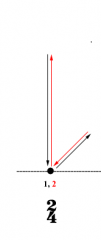
|
|
|
triple beat pattern
|
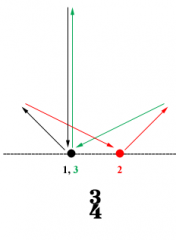
|
|
|
quadruple beat pattern
|
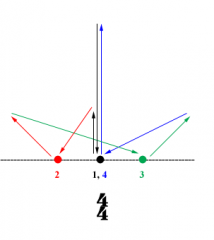
|
|
|
legato style
|
no bouncing or jerking motion in the rebound of any beat; use even, flowing motion throughout the beat pattern--even with a clicked ictus
|
|
|
marcato style
|
crisply executed click and maintaining precision
|
|
|
shoulders
|
should be down, back and relaxed; imagine you have a heavy piece of luggage in each hand
|
|
|
upper arm
|
hanging free from the should so as to act merely as a connector between the shoulder and elbow
|
|
|
elbow
|
positioned several inches out and away from the body and a few inches in front of the body; if it moves from this position, it should follow--never lead--the finger tips; acts as a hing in two directions: up and down, and side-to-side; should always be free and relaxed
|
|
|
forearm
|
acts as a connector between the elbow and wrist; should only move in response to movement of those hinges; never pulls focus away from the lead of the finger tips
|
|
|
wrist
|
should always be a fluid hinge; ready to move when necessary but neither leading nor exhibiting floppy, or rigid tendencies
|
|
|
hand position
|
hand should be held palm down with the fingers slightly rounded and held together while the thumb is extended comfortably out to the side, also rounded as if molded around a large ball; wrist is slightly cocked
|
|
|
fingertips
|
the point of focus and should be pointed directly at the ensemble; do not allow them to droop downward or to be held up too much to expose the open palm or heel of the hand
|
|
|
conducting field
|
will generally cover the area from the chin down to the waist, and the left side of the body over to the outward reach of the finger tips on the right
|
|
|
preparatory gesture
|
clicked ictus and rebound immediately prior to the beginning of the music
|
|
|
for the initial attack
|
mentally establish an exact tempo before beginning; eye contact with the ensemble; no motion before initial beat; energized super click; smooth, even rebound; breathe through the preparatory rebound
|
|
|
final release
|
minimize motion after the ictus of the last note; slowly pull straight up and accelerate downward into the clicked release
|
|
|
3 questions before beginning a piece
|
Tempo--what is it? Style--marcato or legato, size? Confidence--am I prepared?
|
|
|
breath - stop flick
|
make a clear stop at the ictus; flick beginning with the fingertips in the natural direction of the rebound; implied by a check mark
|
|
|
breath - linger
|
prepare the beat before the breath; linger loooong, but do not stop; implied by a comma breath mark
|
|
|
melding
|
de-emphasize all movement after the last ictus that indicated movement; conduct a full-size rebound on the way out of a meld; implied as follows: 1_______p 3 (for example)
|
|
|
super click
|
implied by the use of an asterisk; preceded by a melded gesture; succeeding rebound should be controlled and smooth--avoid jumping out of the super click; use with syncopated pulses
|
|
|
subdivision
|
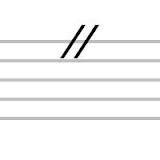
use only when it will clarify conducting (for instance, when a piece slows down significantly); solves the problem of imprecision; will bog down piece if overused; implied by railroad tracks over the staff; illustrating by the beat by keeping the pulse
|
|
|
jogging
|
a type of subdivision where beats are divided into 3 instead of two (i.e. 6/4)
|
|
|
tenuto
|
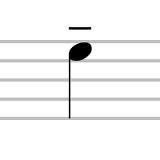
slight lengthening of the note
|
|
|
fermata
|
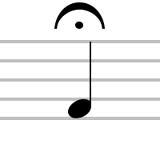
a held, sustained note, the length of which is determined by the conductor
|
|
|
fermata not followed by a breath
|
linger/hold the ictus of the sustained beat, and gently accelerate into the natural rebound of the following beat
|
|
|
fermata followed by a breath--no ictus available for breath
|
hold the ictus of the sustained beat, create an additional beat for the breath by retracing the rebound of the preceding beat with a slightly accelerated motion into the clicked ictus of the newly created beat
|
|
|
fermata followed by a breath--ictus available for breath
|
hold the ictus of the sustained beat; rebound in the natural direction of the beat using an accelerated motion into a strong clucked ictus on the following beat
|
|
|
fermata in simple meter where following note is a fraction of the beat
|
hold the ictus of the sustained beat; rebound in the natural direction of the beat using an accelerated motion into a strong clucked ictus on the following beat
|
|
|
caesura
|
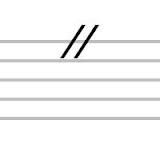
grand pause; indicates a complete stop of sound before recommencing; release the fermata using the accelerating up-down motion used for a final release and then wait--don't move; use a regular prep to come back in
|
|
|
Dynamic
|
changing
|
|
|
quantity
|
loudness or softness; we perceive a louder sound as having more energy than a softer one; dynamic changes must be approached with subtlety and reserve
|
|
|
quality
|
intensity/color of the sound; we perceive a brighter sound as having more energy than one that is dark, round and rich; slight changes in tone/color can create increased energy, but overdoing them can betray musicality
|
|
|
subito markings
|
be ready with new dynamic gestures 1/2 beat early--right after the ictus of the previous beat
|
|
|
crescendo
|
gradual growth in sound, indicated by a movement outward and away from the body
|
|
|
diminuendo
|
gradual decrease in sound, indicated by movement toward the body; do not turn hand until it is close to the body; maintain open posture.
|
|
|
cuing
|
give the cue on the ictus of the beat previous to the vocalist's entrance; give eye contact, a deep singer's breath and
|
|
|
text shaping
|
prudent use of strong weak; reduce the size of the rebound; gently stroke the ictus of the weak beat; can be done by shortening both ictus and rebound, or simply by keeping the rebound low and small
|
|
|
four elements of musical energy
|
pitch, tempo, quantity, quality
|
|
|
pitch
|
we perceive higher pitches as having more energy than low ones; composers control this element
|
|
|
tempo
|
we perceive faster tempos as having more energy; composer will give guidelines, but this decision is ultimately up to the conductor; too much change in tempo can draw unwanted attention to the moment
|
|
|
asymmetrical 5/4 measures
|
conducted with the roll (grouping of 3)/snap (grouping of 2) technique
|

